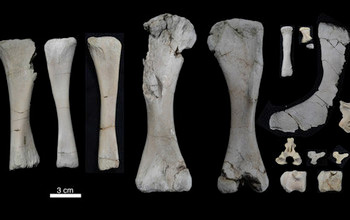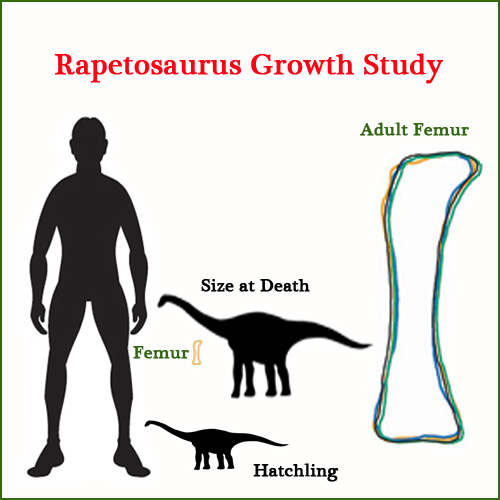Scientists Suggest Rapetosaurus Was Precocial
Titanosaurs are a bit like buses, yes they are. In fact, these bus-sized members of the Sauropodomorpha were a lot like buses, you wait for ages to write about the Titanosauridae and then two stories come along in quick succession. First, there was yesterday’s article all about a remarkable study into the skull of a South American titanosaur (Sarmientosaurus musacchioi), that, thanks to CT scans, had provided researchers with an insight into the dinosaur’s senses and now, we write about another titanosaur study which suggests that these herbivores did not require much or perhaps any parental care after hatching.
Titanosaurs Studied
Titanosaurs – The Largest Land Vertebrates Known
Picture credit: Jennifer Hall
To read more about the study of the skull of Sarmientosaurus musacchioi: A New Late Cretaceous Titanosaur from Patagonia.
Tiny Titanosaur from Late Cretaceous Madagascar
The fossilised bones of a baby titanosaur have been analysed by a team of scientists supported by funding from the National Science Foundation. The team found that hatchlings were mini versions of the adults and just like many birds and reptiles today, these sauropodomorphs were relatively independent at birth, capable of leaving the nesting area and fending for themselves just a short time after hatching. In short, the study suggests that titanosaurs were precocial, the parents having relatively little to do with the raising of the offspring, the youngsters being more than capable of fending for themselves and foraging to find food.
Precocial Behaviour
Precocial behaviour inferred from this study contrasts with different parenting behaviours seen in other types of dinosaur such as ornithopods and the Theropoda. Dinosaurs such as Maiasaura (ornithopod) and Oviraptor (theropod) may have had different parenting strategies. Although, dinosaur nests, embryo fossils and fossils of very young dinosaurs are exceptionally rare there is a degree of evidence, most notably from the “Egg Mountain” site in Montana where the majority of Maiasaura fossils have been unearthed that some dinosaurs at least, were altricial, that is, the young were relatively helpless at birth and they relied on their parents to look after them and to bring food to the nest.
Rapetosaurus karusei – Every Fossil Tells a Story
The titanosaur is Rapetosaurus (R. karusei), fossils of which are associated with the Upper Cretaceous Maevarano Formation of north-western Madagascar. These plant-eaters, roamed the island of Madagascar some 70 million years ago (Maastrichtian faunal stage). Several bones collected between 1998 and 2003 and stored at the State University of New York at Stony Brook and catalogued as crocodilian fossils caught the eye of palaeontologist Kristina Curry Rogers. Kristina has seen fossils like these before and she knew that they were not from any crocodile species, in fact, the bones represented a very young Rapetosaurus. Why was the Associate Professor so confident? Simple, Kristina was one of the researchers which named and described Rapetosaurus (pronounced Rah-pay-too-sore-us) back in 2001.
Some of the Rapetosaurus Material Used in the Study

The preserved skeleton of the baby Rapetosaurus, including vertebrae from the hip and tail and limb bones.
Picture credit: Kristi Curry Rogers
Research Funded by the National Science Foundation
The research was funded the National Science Foundation (United States) and Associate Professor Curry Rogers (Macalester College, St Paul, Minnesota), was the lead author, working with colleagues from Adelphi University, (Garden City, New York), the University of Minnesota and the University of Washington. Looking at the shape of the femur and comparing it to examples from older animals, the bone shape was very similar, this suggested that hatchlings were very mobile and further study indicated that they were capable of a wider range of movements than the cumbersome adults.
Kristina explained:
“This baby’s limbs at birth were built for its later adult mass; as an infant, however, it weighed just a fraction of its future size. This is our first opportunity to explore the life of a sauropod just after hatching, at the earliest stage of its life.”
Shinbone (Tibia) Reveals Data
The team studied thin-sections of the tibia (the bones seen on the left of the picture above), using a high-powered CT scanner to get a closer look at the micro-structures preserved inside the fossil limb bones. The patterns and structures identified were similar to those found in extant animals which made it possible for the scientists to build up a picture of the few short weeks of this dinosaur’s life.
Associate Professor Curry Rogers stated:
“We looked at the preserved patterns of blood supply, growth cartilages at the ends of limb bones, and at bone remodelling. These features indicate that Rapetosaurus grew as rapidly as a newborn mammal and was only a few weeks old when it died.”
For models and replicas of titanosaurs and other dinosaurs: CollectA Deluxe Prehistoric Life Figures.
A Key Finding
One key finding was the identification of the hatching line, a shift in the internal structure of the bone that in modern lizards and crocodilians indicates when an animal emerged from its egg. This enabled the research team to calculate the size of the baby dinosaur at hatching (around 3.4 kilogrammes). The average human baby birth weight in the UK is a fraction heavier at around 3.5 kilogrammes. However, unlike our babies which are highly altricial (dependent on parental care), Rapetosaurus grew rapidly and in the 39 to 77 days of its life it grew to be more than ten times its hatching weight.
A Baby Rapetosaurus Dinosaur Provides Fresh Insight into Titanosaur Growth and Development
Picture credit: Everything Dinosaur based on an original diagram by Kristi Curry Rogers
Demise in a Drought
The baby Rapetosaurus did not live very long and the scientists report that this little herbivore may have starved to death. How did they deduce that? An analysis of cartilage growth plates preserved on the limb bones bears a strong resemblance to the modified growth of cartilage that occurs in living vertebrates when the animal is under stress due to lack of food. The Maevarano Formation represents strata laid down in a flat, alluvial plain criss-crossed by a number of rivers which flowed from the central highlands.
Debris such as large boulders preserved in the strata indicates that the flow of water along these rivers varied a great deal. This suggests a semi-arid environment with prolonged periods of drought, interspersed by periods of heavy rainfall. The Late Cretaceous of Madagascar was a drought-stressed ecosystem and for this hatchling a lack of food was very probably its downfall.
For dinosaur toys and games, visit: Everything Dinosaur.
Thanks to the work of Kristina Curry Rogers and her collaborators, scientists have been able to piece together some information about the short life of this titanosaur.
As Associate Professor Curry Rogers states:
“Between its hatching and death just a few weeks later, this baby Rapetosaurus fended for itself in a harsh and unforgiving environment.”
To read an article about potential precocial behaviour in the Pterosauria: New Species of Flying Reptile from “Pterosaur Graveyard”.








Leave A Comment